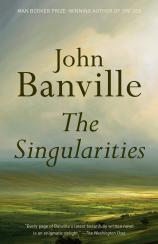The Singularities
Review
The Singularities
In his latest novel, THE SINGULARITIES, Booker Prize-winning Irish novelist John Banville has roamed widely and deeply through his literary oeuvre to revive a collection of characters from previous books and create a smart, stylish story, the essence of which is the attempt to investigate one man’s enigmatic past.
Much of the action occurs at a ramshackle Irish country home known as Arden House. At the request of Adam Godley, William Jaybey, the Axel Vander Chair of Deconstruction Studies at Arcadia State University (a fictional San Francisco college in an unspecified near future), has agreed to take on the project of producing a biography of Godley’s father. Also named Adam, he was a scientist who fashioned something he called the Brahma theory and “whose theories had struck down at a blow the world’s and its wise ones’ notions of what’s what and where’s where and how’s how.” With references to concepts like the “meta-mathematical technique for combining and recombining the infinities” or the “laws that govern the ‘infinite fissuring’ of worldlines,” don’t expect to come away from the novel with much of an understanding of what the theory is all about. But that’s hardly the point.
"Whether you’re one of those loyal Banville fans, or someone coming to his work for the first time, THE SINGULARITIES is a fun ride. Hop on, settle back and let a masterly novelist carry you where he will."
In addition to Adam and his wife, Helen, who is still haunted by the death of an infant son, the inhabitants of Arden House include the senior Godley’s second wife, Ursula, who passes her days alone in an attic room, and Felix Mordaunt (a pseudonym for the character Freddie Montgomery, who was introduced in Banville’s 1989 novel, THE BOOK OF EVIDENCE), a convicted murderer who has been paroled after serving 25 years of a life sentence and returns to the house believing it’s the place where he grew up. THE SINGULARITIES interrogates the complex relationships among these characters, along with a woman, Anna Behrens, who once was a lover of both Godley the elder and Mordaunt and now reunites with the latter for the purpose of presenting him with a desperate request.
Perplexed about why he has been chosen for the role of Godley’s biographer, after he takes up residence at Arden House, Jaybey struggles fitfully to make sense of his subject, “an always elusive person, who greatly enjoyed playing games of catch-me-if-you-can with posterity,” a bit of a self-referential wink by Banville. It’s a task that doesn’t grow easier even after he’s granted access to a jumbled trove of Godley’s private papers. Complicating his effort is the fact that he’s also infatuated with the much younger Helen, who gives no indication of reciprocating his desire. But one thing he knows for certain is that he’s “confident of the rightness of my determination to strip away the myths and misapprehensions that have for so long veiled the figure of Adam Godley in the world’s admiring but hoodwinked gaze.”
The pace of THE SINGULARITIES is leisurely at times, but Banville is such an intelligent and sophisticated guide that it’s always pleasurable to follow him along the winding path he’s navigating. There are few cultural touchstones beyond his ken. Science, art, literature, philosophy, history and mythology (the omniscient narrator of much of the novel is a “mischievous godlet” with mythological roots) are among the fields he visits. One chapter even skillfully satirizes an academic biography, complete with erudite, meticulously formatted footnotes.
Banville is also a gorgeous writer who favors sinuous but shapely sentences. Although it may be hard to believe, in his hands there’s enormous pleasure in reading a full paragraph devoted to the description of a fly, a chair or the anatomy of a scab. At the same time, he’s gifted with the ability to produce crisp, aphoristic prose like, “Life’s nonsense pierces us with strange relations; doesn’t it just.” His descriptions are lovely and precise --- as of a night in a silent, plague-stricken Venice when it “began to snow, lightly and as if absentmindedly, the random flakes not so much falling as faltering in the unsustaining air.” And his similes are sharp and often wry, like this one that captures Ursula’s faltering mental status: “Her memory was like a crate of Meissen figurines that a clumsy porter had dropped on to a marble floor: they were all there…but all smashed to pieces and the pieces in a hopeless jumble.” With words like “crapulous,” “streel,” “haecceity” and “autochthonous,” the book also will be a vocabulary-expanding experience for many.
Assiduous readers of Banville’s previous novels undoubtedly will spend many enjoyable hours poring over the pages of this one, searching for Easter eggs and correspondences between his latest and those earlier works. Whether you’re one of those loyal Banville fans, or someone coming to his work for the first time, THE SINGULARITIES is a fun ride. Hop on, settle back and let a masterly novelist carry you where he will.
Reviewed by Harvey Freedenberg on October 28, 2022
The Singularities
- Publication Date: September 5, 2023
- Genres: Fiction
- Paperback: 320 pages
- Publisher: Vintage
- ISBN-10: 0525564349
- ISBN-13: 9780525564348



